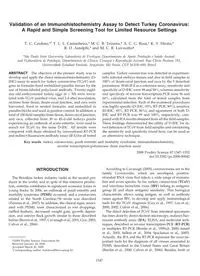
2008 Validation of an Immunohistochemistry Assay to Detect Turkey Coronavirus_ A Rapid and Simple Screening Tool for Lim PDF
Preview 2008 Validation of an Immunohistochemistry Assay to Detect Turkey Coronavirus_ A Rapid and Simple Screening Tool for Lim
Validation of an Immunohistochemistry Assay to Detect Turkey Coronavirus: A Rapid and Simple Screening Tool for Limited Resource Settings T. C. Cardoso,*1 T. L. L. Castanheira,* M. C. B. Teixeira,* A. C. G. Rosa,* K. Y. Hirata,* R. D. Astolphi,* and M. C. R. Luvizotto† *Sa˜o Paulo State University, Laborato´rio de Virologia, Departamento de Apoio, Produc¸a˜o e Sau´de Animal, and †Laborato´rio de Patologia, Departamento de Clinica, Cirurgia e Reproduc¸a˜o Animal, Rua Clo´vis Pestana 793, Universidade Estadual Paulista, Arac¸atuba, Sa˜o Paulo, CEP 16.050-680, Brazil ABSTRACT The objective of the present study was to develop and apply the direct immunohistochemistry (D- IHC) assay to search for turkey coronavirus (TCoV) anti- gens in formalin-fixed embedded-paraffin tissues by the use of biotin-labeled polyclonal antibody. Twenty-eight- day-old embryonated turkey eggs (n = 50) were inocu- lated with TCoV-purified virus, and 3 d after inoculation, sections from ileum, ileum-cecal junction, and ceca were harvested, fixed in neutral formalin, and embedded in paraffin blocks and used as positive control. In addition, a total of 100 field samples from ileum, ileum-cecal junction, and ceca, collected from 30 to 45-d-old turkeys poults experiencing an outbreak of acute enteritis, were used to search for TCoV by the same D-IHC. All results were compared with those obtained by conventional RT-PCR and indirect fluorescent antibody assay (IFA) for all tested Key words: turkey coronavirus, poult enteritis and mortality syndrome, immunohistochemistry, reverse transcription-polymerase chain reaction assay 2008 Poultry Science 87:1347–1352 doi:10.3382/ps.2008-00042 INTRODUCTION The Brazilian turkey industry ranks as the second pro- ducer in the world, and in spite of this intensive produc- tion, enteritis contributes to significant economic losses in young flocks. In 2006, an outbreak of poult enteritis and mortality syndrome (PEMS) occurred, and a coronavirus related to the North Caroline/96 strain was described (Teixeira et al., 2007). In addition, the clinical signs, associ- ated with PEMS, were characterized as wet droppings, ruffled feathers, decreased weight gain, growth depres- sion, and uneven flock growth similar to those described before (Brown et al., 1997; Cavanagh et al., 2001; Guy, 2003; Culver et al., 2006). ©2008 Poultry Science Association Inc. Received January 24, 2008. Accepted March 20, 2008. 1Corresponding author:
